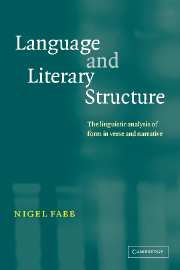5 - Lines
Published online by Cambridge University Press: 22 September 2009
Summary
Lineation is implied
In this chapter I will show that lineation, the division of a text into lines, is a kind of implied form, not an inherent fact of the text. Because there are many kinds of evidence for the division into lines, there are usually many competing options for how the text is divided up. In most texts, one lineation is dominant but I will suggest that other alternative lineations remain weakly present. This can be assimilated to Sperber and Wilson's suggestion that poetic effects involve a mass of weak implicatures; here I propose that the weak implicatures of alternative lineations are experienced as aesthetic. In some texts, no single lineation is dominant, and the text is ambiguous in lineation, which is a kind of high-level complexity, which in turn may be experienced as aesthetic. Thus verse is inherently contradictory and complex and thereby inherently aesthetic.
The apparent determinacy of lineation comes from the fact that there are strong implicatures relating to lineation both in writing and in speech. For writing we might have explicatures such as (1) and conditionals such as (2):
This word has no words on the page to its right.
- Type
- Chapter
- Information
- Language and Literary StructureThe Linguistic Analysis of Form in Verse and Narrative, pp. 136 - 177Publisher: Cambridge University PressPrint publication year: 2002



